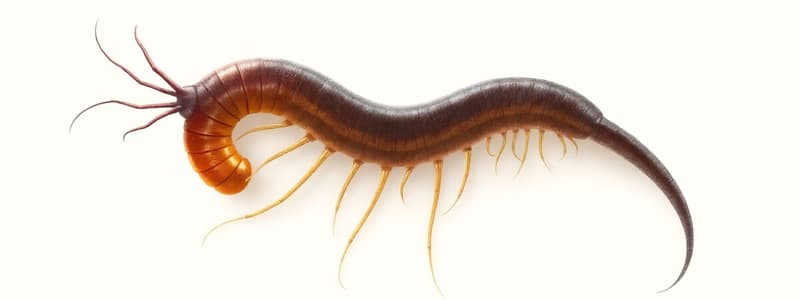Podcast
Questions and Answers
What is the primary mode of infection for humans by DARCUNCULUS MEDINENSIS?
What is the primary mode of infection for humans by DARCUNCULUS MEDINENSIS?
- Contact with infected wounds
- Drinking water containing infected cyclops (correct)
- Inhalation of infected particles
- Ingesting infected meat
What happens to the male DARCUNCULUS MEDINENSIS after fertilizing the female?
What happens to the male DARCUNCULUS MEDINENSIS after fertilizing the female?
- It transforms into a parasite
- It migrates further into the host
- It continues to live and mate
- It dies (correct)
Which effect is NOT caused by the toxic substances released by the female DARCUNCULUS MEDINENSIS?
Which effect is NOT caused by the toxic substances released by the female DARCUNCULUS MEDINENSIS?
- Local inflammatory reaction
- Blisters on the skin
- Urticaria and erythema
- Severe abdominal pain (correct)
In the laboratory, how is DARCUNCULUS MEDINENSIS diagnosed?
In the laboratory, how is DARCUNCULUS MEDINENSIS diagnosed?
How long can the adult female DARCUNCULUS MEDINENSIS grow?
How long can the adult female DARCUNCULUS MEDINENSIS grow?
Which of the following hosts does NOT harbor Trichinella species?
Which of the following hosts does NOT harbor Trichinella species?
What is the length of a typical adult female Trichinella spiralis?
What is the length of a typical adult female Trichinella spiralis?
Which of the following statements is true about the life cycle of Trichinella spiralis?
Which of the following statements is true about the life cycle of Trichinella spiralis?
Flashcards
Guinea worm lifecycle
Guinea worm lifecycle
Infected water containing Cyclops (intermediate host) is ingested. The larvae mature in subcutaneous tissue, causing a blister, and eventually emerge.
Medina worm morphology
Medina worm morphology
Adult female is long (up to 1 meter), white, and smooth. Males are short and die after fertilizing the female. Larvae are large (500-700 micrometers) with a rounded head and pointed tail.
Guinea worm habitat
Guinea worm habitat
Subcutaneous tissue of lower limbs.
Guinea worm infection
Guinea worm infection
Signup and view all the flashcards
Trichinella species
Trichinella species
Signup and view all the flashcards
Trichinella adult morphology
Trichinella adult morphology
Signup and view all the flashcards
Guinea worm diagnosis
Guinea worm diagnosis
Signup and view all the flashcards
Trichinella distribution
Trichinella distribution
Signup and view all the flashcards
Study Notes
Guinea Worm (Dracunculus medinensis)
- Distribution: Found in areas where people use shallow ponds or open wells for drinking water.
- Adult Morphology: White, smooth-surfaced. Females are very long (up to 1 meter), males die after fertilizing.
- Adult Habitat: Subcutaneous tissue of lower limbs.
- Larva Morphology: Large (500-700 mm), rounded anterior end, pointed tail. Can be seen coiled or uncoiled in wet preparations.
- Intermediate Host: Cyclops, live in water. Humans become infected by drinking water containing infected Cyclops.
Trichinella spiralis
- Hosts: Domestic pigs, rats, cats and dogs. T. nativa infects all carnivores. T. nelsoni infects carnivores and wild pigs.
- Distribution: Africa, Asia, and America.
- Adult Morphology: White, very small. Female: 4mm, bluntly rounded posterior end, single ovary, vulva in body half. Male: 1.5mm, curved posterior end with two lobular caudal appendages.
- Adult Habitat: Small intestine.
- Larva Morphology: Coiled inside lemon-shaped cysts, lie longitudinally along muscle fibers. Calcified larvae appear black.
- Life Cycle: Direct life cycle. Definitive host: Pigs. Accidental host: Humans (dead end). Infective form: encysted larva in muscle, ingestion of raw or undercooked meat.
Guinea Worm (Dracunculus medinensis) - Pathology and Symptoms
- Pathology: When the female reaches the surface of the body, it releases toxic substances causing local inflammatory reaction (blister formation).
- Symptoms: Blister formation, urticaria (hives), erythema (redness), vomiting, fever, secondary infections, abscesses, ulceration, necrosis, cellulitis, septicemia.
Guinea Worm (Dracunculus medinensis) - Lab Diagnosis
- Diagnosis: Primarily during blister rupture. Larvae are usually washed into water, so lab identification is difficult.
- Method: Placing water on ulcer to encourage discharge of larvae, collecting on slide for microscope examination.
Guinea Worm (Dracunculus medinensis) - Treatment
- Treatment: Slow process of daily gently rolling the worm around a small stick and slowly pulling it out from the skin while taking precaution not to pull apart the worm.
Trichinella spiralis - Symptoms
- Symptoms: Trichinellosis. Symptoms are often mild, Severe trichinellosis cases can result in fever, chills, facial swelling, joint and muscle aches, and rash.
Trichinella spiralis - Lab Diagnosis
- Methods: Muscle biopsy (direct or digestion technique), intradermal test (e.g., Bachman skin test), stool examination (to detect adult worms in diarrhea) Xenodiagnosis, serology (e.g., ELISA, Latex agglutination test).
Studying That Suits You
Use AI to generate personalized quizzes and flashcards to suit your learning preferences.




